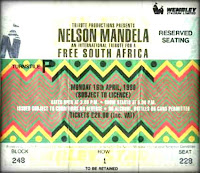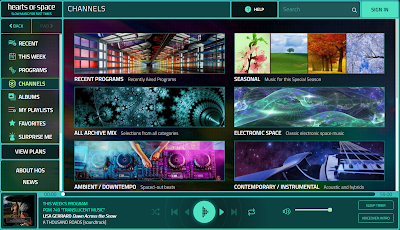"I'm looking for you in the crowd."
"But Mum, I wasn't there!!"
I'm not sure why I wasn't at Live Aid, 40 years ago today. As a committed concert-goer back then, I certainly would have been up for it. I imagine the event must have sold out quickly before I could get hold of a ticket.
On the day, I remember I was in my car with the radio on, and hearing the now famous announcement: "It's 12 noon in London, 7am in Philadelphia and around the world it's time for Live Aid!"
I watched the day unfold on TV with friends, into the early hours of Sunday morning. I still have the audio tapes. On one of them, at the conclusion of Led Zeppelin's Stairway To Heaven, you hear DJ Mike Smith saying "Well, if you won't give us at least a quid after hearing the most requested song of all time, well, there's no hope is there?"
 |
| My Live Aid cassettes |
So while much is rightly being made of the 40th anniversary of Live Aid, the humanitarian and charity events that followed it are also an important part of the story. As such, the immediate legacy of Live Aid was the string of politically-charged concerts in the late 80s, beginning with another cracker of an event music-wise, the Nelson Mandela 70th Birthday Tribute at Wembley Stadium in June 1988.
 |
| My ticket |
The June 1988 concert that spurred the release
from jail of Nelson Mandela, was a remarkable collection of global talent. More
diverse than Live Aid and featuring many of the biggest artists of the day.
It was probably the most politically influential of any concert held in the UK. The BBC fended off resistance to the idea of giving a whole day's TV (again!), not for famine relief this time, but to support the release of a political prisoner.
Mandela had at this point served 26 years in prison. After the 70th Birthday Tribute concert was shown around the world (except in South Africa, of course), growing domestic and international pressure forced President F. W. de Klerk to release Mandela in 1990 and negotiate an end to apartheid. In 1994 Mandela became president of South Africa.
Here’s the list of artists who appeared at the June 1988 show:
George Michael also went on early in the show and bravely chose to cover Stevie Wonder’s Village Ghetto Land.
Unfortunately for Stevie, and for us, the hard drive for his keyboards went missing just as he was about to take the stage. His scheduled performance was scrapped and Tracy Chapman stepped forward with her guitar and played Fast Car. Apparently, her record sales went stratospheric after this.
Simple Minds came on and pumped up the audience with Waterfront and Alive and Kicking.
The day would not have been complete without Jerry Dammers and an augmented Special AKA performing Free Nelson Mandela, with Ndonda Khuze on vocals. As the carnival vibes were ramped up, the crowd chanted The Whole World Is Watching!!In the Royal Box, Neil and Glenys Kinnock were rocking and rolling. It was a birthday party, why not?
Whitney Houston won the audience over with the sheer power
of her voice. Her appearance on the bill was perhaps seen as tame in the midst of the other edgier artists, but after a few of her trademark vocal somersaults, we all looked at each like, wow, this girl can sing. It was a phenomenal performance, in less than ideal conditions for her, in the open air with the temperature dropping.
Then Stevie Wonder appeared suddenly. No keyboards, just standing at the mike calling out the key changes to the band. He didn't stay long. It fell a bit flat, to be honest.
Night fell and Billy Connolly come on to introduce Dire Straits. He told us that when the band's album went to number one in South Africa, rather than take the royalties, they said send the money to Amnesty International.
"It must break the hearts of those shits to sign the cheque every year and send it off. And as result, the boys are banned in South Africa, which is a compliment. Ladies and gentlemen, with a happy heart and a tear in either eye...Dire Straits".
The band sounded immaculate and the emotional atmosphere was palpable as Dire Straits played Brothers In Arms. I've rarely witnessed such a charged atmosphere at a show. Maybe this clip gives some sense of what it was like. Mark Knopfler was clearly affected by it.
The perfect end to a special day. Jessye Norman sang Amazing Grace at the finale.
The second Nelson Mandela concert, in April 1990 also at Wembley, was notable less for the music (although it was another bumper list of artists) but most of all because Mandela was there in person.That remains one of the most thrilling and inspiring moments of my life. After 27 years in prison, he walked out on the stage to a massive ovation. It seemed to last a long time - in fact it was only about 6 minutes - before he was able to speak.
 |
| Nelson Mandela on stage at Wembley |
 |
| My ticket |
As the decade came to a close, the fall of the iron curtain across Eastern Europe and the release of Mandela were the culmination of this new sense that people did have the power to force change. Oppression and inequality hasn't gone away, but events such as this gave us the belief that change can happen when people come together to show their opposition and resistance.











.jpg)




















